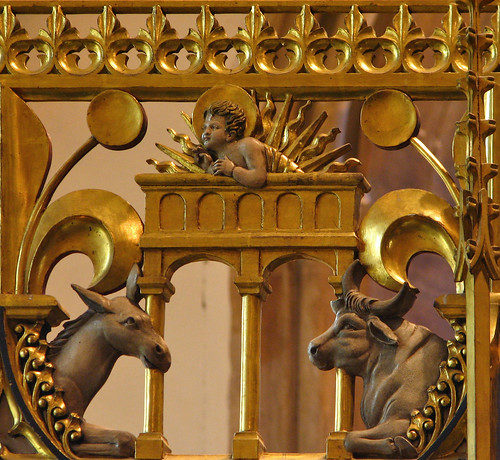 These two animals are the ox and the donkey, and we find them in Nativity scenes in church and in Christian art, and we mention them in carols and liturgical songs. Yet, there is no mention of these beasts in the Gospels themselves. The only animals mentioned in the infancy narratives are the flock over which the shepherds watched (Luke 2:8). Why, then, are they given such prominence in our liturgical and artistic tradition? And why did St Francis of Assisi - who 'invented' the first Crib scene as a devotional tableau - specifically ask that Christ be depicted in his crib between an ox and a donkey? Is this just further evidence of his reputed love for animals?
These two animals are the ox and the donkey, and we find them in Nativity scenes in church and in Christian art, and we mention them in carols and liturgical songs. Yet, there is no mention of these beasts in the Gospels themselves. The only animals mentioned in the infancy narratives are the flock over which the shepherds watched (Luke 2:8). Why, then, are they given such prominence in our liturgical and artistic tradition? And why did St Francis of Assisi - who 'invented' the first Crib scene as a devotional tableau - specifically ask that Christ be depicted in his crib between an ox and a donkey? Is this just further evidence of his reputed love for animals?The ox and the donkey are not merely products of a pious imagination or animal-loving sentimentality, however. They have their basis in this prophecy of Isaiah: "The ox knows its owner, and the ass its Master's crib; but Israel does not know, my people does not understand" (Isaiah 1:3). The Fathers of the Church saw in these words a prophecy that pointed to Christ's birth and particularly to the fact that Christ was laid in a manger, a feeding trough for stabled animals. A manger was used as the Master's crib, and so the Fathers reasonably surmised that there would be animals around the makeshift crib, notably the ox and donkey prophesied by Isaiah. Thus, the responsory above repeats that Christ was found lying in a manger, and stresses that there were not just dumb animals beholding the incarnate Lord but two animals: the perceptive animals foretold by Isaiah.
The point of all this is to identify the helpless baby lying in the rough manger as the Master and Lord of all, the longed-for Saviour promised by Isaiah. It is he whom the ox and donkey recognise. It is also fitting that the Lord, who gives his Body and Blood to us in the form of food and drink should be found lying in a feeding trough. In a sense then, we are called to follow the example of the ox and the donkey, marvelling at Our Lord, not now lying in a manger but upon the Altar as our Bread of Life.
The presence of the ox and donkey in our crib scenes and on Christmas cards is thus also a challenge to us. For, by some miracle, they know and understand who the new-born Jesus is. But do we, who are naturally rational animals? Do we human animals recognise the Lord present in the wonderful sacrament of the Eucharist, present in the signs and mystery of the Church, and present in our fellow men, especially those who like the baby Jesus are weak, vulnerable, helpless, dependent and needy? We may claim that we know who Jesus is, but is that actually evident in the way that we live, or do we rather behave like dumb animals without reason, knowledge and understanding? It is questions such as these which confront all of us as we approach Christmas once again.
Amidst the busyness of an uncomprehending world which celebrates the festival with little knowledge or love of him, let us pause to contemplate the Lord lying in a manger between two animals, and recognise the great and wonderful mystery of Emmanuel, God-with-us.
I have found the 'characters of advent' series really useful. thanks :)
ReplyDeleteA wonderful explanation; thank you very much. Where is this carving to be found which you used as an image?
ReplyDelete